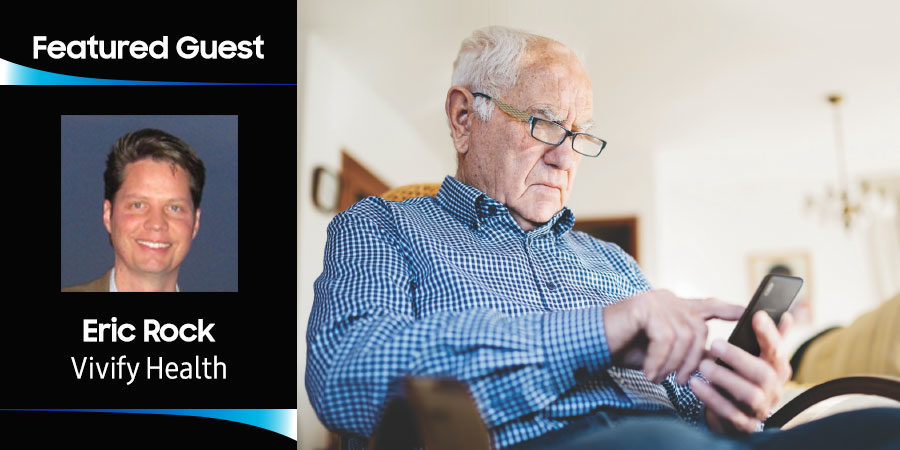Editor’s Note: This conversation is part of our ongoing “Future State Of” series. It has been edited for length and clarity.
Keeping the country healthy is critical during a crisis. However, the COVID-19 pandemic has upended many of the traditional ways we deliver and receive healthcare. Innovators have had to step in and step up to address these issues. One of those innovators is Vivify Health, a leader in the quickly expanding digital healthcare delivery space through services like remote patient monitoring. Taher Behbehani, GM and SVP of Samsung B2B, sits down with Vivify CEO Eric Rock to discuss COVID-19’s impact on the ways patients receive digital healthcare and what enhanced remote monitoring means for the future.
Taher Behbehani: Hi Eric, and thanks for speaking with me today. You must be super busy with everything that’s going on in the digital healthcare space.
Eric Rock: The whole market’s heating up with all kinds of shiny objects and potentially beautiful products that still need to scale. Opportunities are moving very quickly with things like ambient, AI, machine learning, aging in place, family caregiver and simpler virtual visits for the 80-year-old population. All kinds of wonderful things that we’re trying to stay ahead of the curve on innovation.
TB: I know that telemedicine is surging during the crisis, but your service goes beyond simple telemedicine, right?
ER: Our service is care that continues. We are replacing the episodic approach to healthcare and have created a holistic connected care platform. It’s very different than just traditional telemedicine. When a member says, “I’ve just had surgery and am not feeling well. I want some help,” our service manages your chronic conditions and your complex, episodic events, such as post-discharge from surgery.
TB: Can you give me a sense of what’s happening right now in your business and what you think is going to happen in the future in light of everything going on?
ER: Remote monitoring was clearly made for COVID-19, and we are without question at the front line of all of this, as Samsung has experienced with us. But we have been here before. We have a shared history during prior pandemics, where Samsung partnered with us to help monitor Ebola, as we had frontline workers who were impacted by Ebola back in 2014.
Our platform had grown over the years to facilitate the rapid creation of solutions through our patient-facing technology. All these capabilities helped us deliver, literally in a 24-hour period, the CDC guidelines for basic screening. What we’ve done with COVID over the past five months has been tremendous with solutions to help every patient we can across our broad customer footprint. And those are not only the patients in a hospital, but also those frontline caregivers who are creating risk for everybody else.
Initially, the solutions we created were basics, such as screening, following and enhancing CDC guidelines and monitoring. Once their risks increased to the point they should be monitored, we provide that as well. With screening, we’re guiding to self-isolation, which is flattening the curve. With monitoring, we’re helping them actually deliver care, keeping them at home safely, which is also flattening the curve. And now we’re progressing into other solutions as we transition through this pandemic into back-to-the-office solutions. We have large providers, payers and communities that are serving employers with solutions to help get back to business by helping them manage their own employee base.
TB: How has addressing these important public health challenges impacted your company’s growth trajectory?
ER: The five years prior to COVID we had 100 percent annual growth. With COVID, in just the last six months, we’ve seen an over 700 percent growth in our business with total population monitored. This is not just a virtual visit, as you see across the industry. This is connected care that’s continual. And so the benefits that spill off of COVID as we’re transforming healthcare delivery are tremendous.
With COVID, we now have approximately a thousand hospitals, which include the largest health systems in the U.S. And 80 percent of those customers expanded with our COVID capabilities, under existing deployment of Vivify, overnight. Hundreds of thousands of patients and frontline healthcare workers are actively engaged with our COVID solution and growing as we progress.
So this means we are able to give back to the community and give back to our customers and frontline healthcare workers. We do this by offering our COVID capabilities at a low barrier of entry for the initial screening, and at a discounted rate when they’re getting into more costs like monitoring. We certainly did not want to take advantage of the market, and we wanted to help our customers accomplish better care. We hope and believe down the line that we’re going to see more growth generally, and actually we are seeing it with connected care beyond COVID.
TB: And when you are successful, that also empowers providers to be successful, right?
ER: The great part is that we’re saving money for providers and payers by giving them new methods for reimbursement as they transition to value-based markets. We are the technology that helps them accomplish value-based reimbursement, because providers are now measured by their outcome, rather than checking the box in a fee-for-service visit. It’s how they’re transitioning to value-based reimbursement, and the member or patient is now getting better, more convenient care. Everybody wins.
TB: Looking back at the pandemic, what would you have done differently as a CEO?
ER: The rapid scale hit us hard. I would have liked to have hired more people up front to support that scale. No one could have predicted over 700 percent growth. But fortunately, we had good processes and customers that understood we were all hit hard, so we survived and thrived through that with relationships that we had built with our customers. So COVID has given us some more lessons learned. We need a path toward a much larger impact we can have with device readiness, so that we can connect directly with those patients when the next event like this hits. And so partnership with Samsung is very important there.
TB: As we look ahead, what are the trigger points that will help move this new type of B2B2C patient care forward?
ER: I think it just happened. Healthcare is unique. It’s very complex and it often takes significant events, such as a pandemic, to bring on change in healthcare. And we’ve just had that. Providers and consumers were forced to experience virtual and remote care through COVID, and now that they have, they love it. Consumers realize that in addition to the convenience, it’s still the same doctor or nurse that they already trust, but now it’s delivered virtually within the comfort of their home, and without the long drive and the long wait in the office where they may have increased risk of catching yet another virus.
TB: What age group is more likely to adapt to this new environment?
ER: Those that have the greatest needs adapt. The elderly population without question, and they’re the hardest to actually deliver technology solutions for. Having an 80-year-old who has never touched a smart device in their life actually accomplish this makes them proud. They can show their grandchildren: “hey look, I’m using a tablet, too.”
TB: What can Samsung do to help you?
ER: One of the most important measurement criteria for success is that patients have engagement. And a big part of that is removing patient friction or barriers to activate. And one of those largest factors is improved devices for that highest risk population. A lot of these people are 90 and 100 years old. And so having solutions that are more designed for that population. To have Samsung innovate with healthcare-specific, or elderly-specific solutions, we would love to partner with you on that.
TB: Absolutely. We are looking forward to the challenge.
Discover how Samsung’s digital health solutions are leading the new era of care. And keep up to date with the latest announcements and insights by following Taher Behbehani on Twitter.








